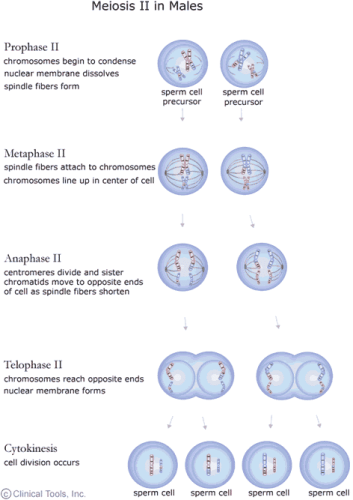The Cell Cycle -Cell Cycle And Cell Division,Class 11, Biology - NEET PDF Download
When does meiosis exactly occur?I mean to say like mitosis occurs during the m phase of cell cycle in which part does meiosis occur?
Ref: https://edurev.in/question/625799/When-does-meiosis-exactly-occur-I-mean-to-say-like-mitosis-occurs-during-the-m-phase-of-cell-cycle-i
The cell cycle
Living cells go through a series of stages known as the cell cycle. The cells grow, copy their chromosomes, and then divide to form new cells.
The cell cycle
G1 phase. The cell grows.
S phase. The cell makes copies of its chromosomes. Each chromosome now consists of two sister chromatids.
G2 phase. The cell checks the duplicated chromosomes and gets ready to divide.
M phase. The cell separates the copied chromosomes to form two full sets (mitosis) and the cell divides into two new cells (cytokinesis).
The period between cell divisions is known as 'interphase'.
Cells that are not dividing leave the cell cycle and stay in G0.
Mitosis and meiosis
Cells divide into two different ways to make new cells.
Mitosis
Mitosis is used to produce daughter cells that are genetically identical to the parent cells. The cell copies - or 'replicates' - its chromosomes, and then splits the copied chromosomes equally to make sure that each daughter cell has a full set.
Meiosis
Meiosis is used to make special cells - sperm cells and egg cells - that have half the normal number of chromosomes. It reduces the number from 23 pairs of chromosomes to 23 single chromosomes. The cell copies its chromosomes, but then separates the 23 pairs to ensure that each daughter cell has only one copy of each chromosome. A second division that divides each daughter cell again to produce four daughter cells.
Mitosis and meiosis
Mitosis
Your body contains trillions of cells (thousands of millions). But you started life as a single cell - a fertilised egg cell. This cell then divided and divided to make more cells through a process called mitosis.
Mitosis is a way of making more cells that are genetically the same as the parent cell. It plays an important part in the development of embryos, and it is important for the growth and development of our bodies as well. Mitosis produces new cells, and replaces cells that are old, lost or damaged.
In mitosis a cell divides to form two identical daughter cells. It is important that the daughter cells have a copy of every chromosome, so the process involves copying the chromosomes first and then carefully separating the copies to give each new cell a full set.
Before mitosis, the chromosomes are copied. They then coil up, and each chromosome looks like a letter X in the nucleus of the cell. The chromosomes now consist of two sister chromatids. Mitosis separates these chromatids, so that each new cell has a copy of every chromosome.
A diagram of a cell ready for mitosis. The copied chromosomes consist of two chromatids joined at the centromere
The process of mitosis involves a number of different stages. The following diagram sets out the stages, and the main events that occur in each stage.
The phases of mitosis
Meiosis
Some simple organisms - such as bacteria - can reproduce by simply dividing into two new individuals. Other organisms, including human beings, reproduce through sexual reproduction. New individuals are formed by the joining together of two special cells: a sperm cell and an egg cell.
The cells in our bodies contain 23 pairs of chromosomes - giving us 46 chromosomes in total. Sperm cells and egg cells contain 23 single chromosomes, half the normal number, and are made by a special form of cell division called meiosis.
Meiosis separates the pairs of matching (or 'homologous') chromosomes, so that sperm cells and egg cells have only one copy of each. That way, when an egg cell fuses with a sperm cell, the fertilised egg has a full set: that is, two copies of every chromosome.
Meiosis involves two cell divisions: Meiosis I and Meiosis II.
Meiosis I separates the matching - or 'homologous' - pairs of chromosomes.
Meiosis II divides each chromosome into two copies (much like mitosis).
In Meiosis I, each daughter cell receives a mix of chromosomes from the two sets in the parent cell. In addition, the chromosomes in each matching pair swap some genetic material before they are parted in a process called crossing over. These processes produce new combinations of genes in the sperm cells and egg cells.
The following diagrams set out the main stages of Meiosis I and Meiosis II in males. (A similar process in females produces egg cells rather than sperm cells.)

FAQs on The Cell Cycle -Cell Cycle And Cell Division,Class 11, Biology - NEET
| 1. What is the cell cycle and why is it important? |  |
| 2. What are the different phases of the cell cycle? |  |
| 3. What is the role of checkpoints in the cell cycle? |  |
| 4. How is cell division regulated in the cell cycle? |  |
| 5. What are the consequences of abnormal cell cycle regulation? |  |

|
Explore Courses for NEET exam
|

|

















